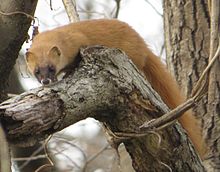
Back ابن عرس ياباني Arabic ابن عرس يابانى ARZ Niponaf Telibol (Mustela itatsi) AVK موستلا یتاتسی AZB Японски колонок Bulgarian Kaerell Japan Breton Mostela del Japó Catalan Mustela itatsi CEB Japan-Wiesel German Mustela itatsi Spanish
| Japanese weasel | |
|---|---|

| |
| Scientific classification | |
| Domain: | Eukaryota |
| Kingdom: | Animalia |
| Phylum: | Chordata |
| Class: | Mammalia |
| Order: | Carnivora |
| Family: | Mustelidae |
| Genus: | Mustela |
| Species: | M. itatsi
|
| Binomial name | |
| Mustela itatsi Temminck, 1844
| |

| |
| Japanese weasel range (blue - native, red - introduced) | |
The Japanese weasel (Mustela itatsi) is a carnivorous mammal belonging to the genus Mustela in the family Mustelidae. The most closely related Mustela species is the Siberian weasel (Mustela sibirica). Its taxonomic species name, itatsi, is based on the Japanese word for weasel, itachi (イタチ). It is native to Japan where it occurs on the islands of Honshū, Kyūshū and Shikoku.[2] It has been introduced to Hokkaidō and the Ryukyu Islands to control rodents and has also been introduced to Sakhalin Island in Russia.[3][4]
It has an orange-brown coloured fur coat with darker markings on the head and varies in size depending on its gender.[5][6] They have a long slender body, a long tail, relatively short legs and sharp claws. It is often confused with the Siberian weasel which has a different ratio of tail to head and body length.[5] Unlike other species of weasels, their coat does not change colour in winter.[7] Average lifespan of a Japanese weasel is highly dependent on the availability of food and to a lesser extent other factors that affect its life. In the wild it can live for 2 to 3 years with the highest in the range living to about 5 years.[8] The Japanese weasel has a tail ratio of 36–50% while the Siberian weasel has a ratio greater than 50%. The population of the Japanese weasel has seen a decline of 25% over the last 3 generations which has been used to justify its status as near threatened on the IUCN Red List. The government of Japan has prevented the hunting of female Japanese weasels as a measure to conserve the species.[1]
It is often classified as a subspecies of the Siberian weasel (M. sibirica). The two species are very similar in appearance but differ in the ratio of tail length to head and body length.[2] There are also genetic differences which suggest that the two diverged around 1.6–1.7 million years ago.[2] Mitochondrial sequencing of the two species suggests that the two species diverged in the Early Pleistocene.[9] Their ranges now overlap in western Japan where the Siberian weasel has been introduced.[2]
Adult males of the Japanese weasel can reach 35 cm (14 in) in body length with a tail length of up to 17 cm (6.7 in).[3] Females are smaller. The species typically occurs in mountainous or forested areas near water.[3] Its diet includes mice, frogs, reptiles, insects and crayfish.[3][10]
- ^ a b Kaneko, Y.; Masuda, R.; Abramov, A.V. (2016). "Mustela itatsi". IUCN Red List of Threatened Species. 2016: e.T41656A45214163. doi:10.2305/IUCN.UK.2016-1.RLTS.T41656A45214163.en. Retrieved 2 July 2021.
- ^ a b c d Masuda, Ryuichi & Yoshida, Michihiro C. (1994). "Nucleotide sequence variation in Cytochrome b genes in three species of weasels Mustela itatsi, Mustela sibirica and Mustela nivalis, detected by improved PCR product-direct sequencing technique". Journal of the Mammalogical Society of Japan. 19 (1): 33–43. doi:10.11238/jmammsocjapan.19.33. S2CID 82558463.
- ^ a b c d Kodansha (1993) Japan: an illustrated encyclopedia, Kodansha, Tokyo.
- ^ Wilson, D. E.; Reeder, D. M., eds. (2005). Mammal Species of the World: A Taxonomic and Geographic Reference (3rd ed.). Johns Hopkins University Press. ISBN 978-0-8018-8221-0. OCLC 62265494.
- ^ a b Hooper, R. (2003). "Japanese weasel". The Japan Times. Retrieved 21 March 2020.
- ^ Sasaki, Hiroshi; Ohta, Kyoko; Aoi, Toshiki; Watanabe, Shigeki; Hosoda, Tetsuji; Suzuki, Hitoshi; Abe, Mikiko; Koyasu, Kazuhiro; Kobayashi, Syuji & Oda, Sen-ichi (2014). "Factors affecting the distribution of the Japanese weasel Mustela itatsi and the Siberian weasel M. sibirica in Japan". Mammal Study. 39 (3): 133–139. doi:10.3106/041.039.0302. S2CID 85817570.
- ^ Nicol, C. (2020). "What's 'Weasely' About Wonderful Weasels?". The Japan Times. Retrieved 28 May 2020.
- ^ VanNatta, E. (2020). "Mustela Itatsi (Japanese Weasel)". Animal Diversity Web. Retrieved 30 April 2020.
- ^ Shalabi, Mohammed A.; Abramov, Alexei V.; Kosintsev, Pavel A.; Lin, Liang-Kong; Han, Sang-Hoon; Watanabe, Shigeki; Yamazaki, Koji; Kaneko, Yayoi & Masuda, Ryuichi (2016). "Comparative phylogeography of the endemic Japanese weasel (Mustela itatsi) and the continental Siberian weasel (Mustela sibirica) revealed by complete mitochondrial genome sequences". Biological Journal of the Linnean Society. 120 (2): 333–348. doi:10.1111/bij.12891. S2CID 89424163.
- ^ Sekiguchi, Keishi; Ogura, Go; Sasaki, Takeshi; Nagayama, Yasuhiko; Tsuba, Kohiyun & Kawashima, Yoshitugu (2002). "座間味島におけるニホンイタチ(Mustela itatsi)の夏季および秋季の食性と在来種への影響" [Food habits of introduced Japanese weasels (Mustela itatsi) and impacts on native species on Zamami Island]. Mammalian Science. 42 (2): 153–160. doi:10.11238/mammalianscience.42.153. Archived from the original on 2012-02-17. Retrieved 2008-10-23.
